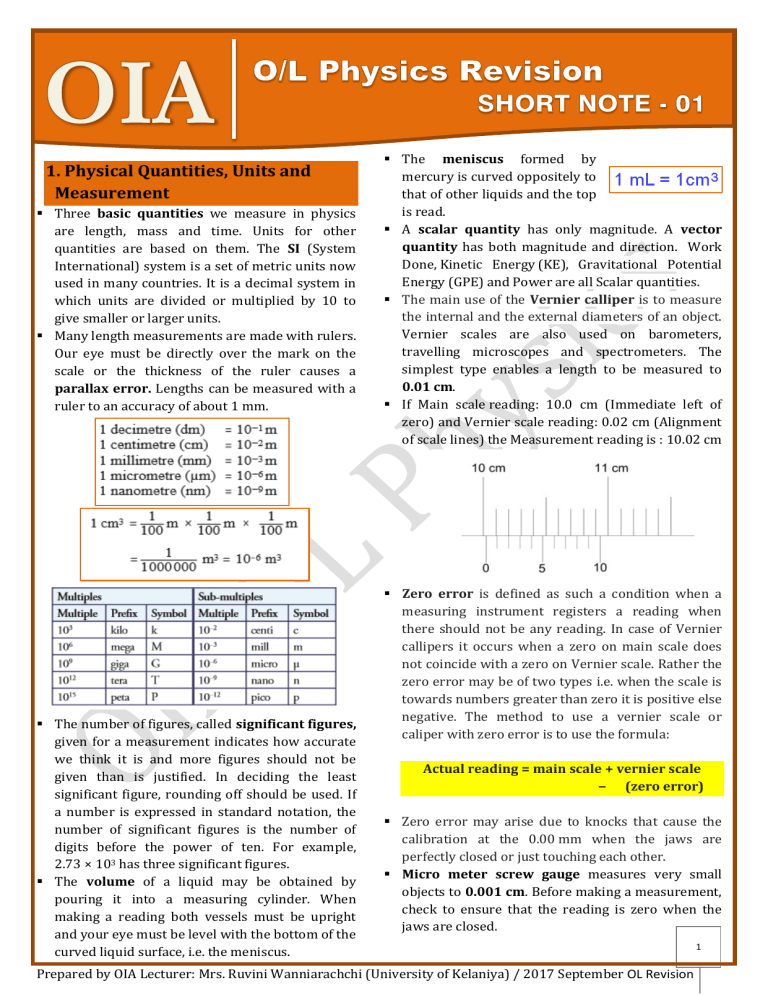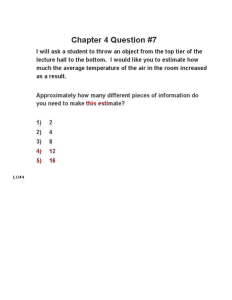
1. Physical Quantities, Units and Measurement Three basic quantities we measure in physics are length, mass and time. Units for other quantities are based on them. The SI (System International) system is a set of metric units now used in many countries. It is a decimal system in which units are divided or multiplied by 10 to give smaller or larger units. Many length measurements are made with rulers. Our eye must be directly over the mark on the scale or the thickness of the ruler causes a parallax error. Lengths can be measured with a ruler to an accuracy of about 1 mm. The number of figures, called significant figures, given for a measurement indicates how accurate we think it is and more figures should not be given than is justified. In deciding the least significant figure, rounding off should be used. If a number is expressed in standard notation, the number of significant figures is the number of digits before the power of ten. For example, 2.73 × 103 has three significant figures. The volume of a liquid may be obtained by pouring it into a measuring cylinder. When making a reading both vessels must be upright and your eye must be level with the bottom of the curved liquid surface, i.e. the meniscus. The meniscus formed by mercury is curved oppositely to that of other liquids and the top is read. A scalar quantity has only magnitude. A vector quantity has both magnitude and direction. Work Done, Kinetic Energy (KE), Gravitational Potential Energy (GPE) and Power are all Scalar quantities. The main use of the Vernier calliper is to measure the internal and the external diameters of an object. Vernier scales are also used on barometers, travelling microscopes and spectrometers. The simplest type enables a length to be measured to 0.01 cm. If Main scale reading: 10.0 cm (Immediate left of zero) and Vernier scale reading: 0.02 cm (Alignment of scale lines) the Measurement reading is : 10.02 cm Zero error is defined as such a condition when a measuring instrument registers a reading when there should not be any reading. In case of Vernier callipers it occurs when a zero on main scale does not coincide with a zero on Vernier scale. Rather the zero error may be of two types i.e. when the scale is towards numbers greater than zero it is positive else negative. The method to use a vernier scale or caliper with zero error is to use the formula: Actual reading = main scale + vernier scale − (zero error) Zero error may arise due to knocks that cause the calibration at the 0.00 mm when the jaws are perfectly closed or just touching each other. Micro meter screw gauge measures very small objects to 0.001 cm. Before making a measurement, check to ensure that the reading is zero when the jaws are closed. Prepared by OIA Lecturer: Mrs. Ruvini Wanniarachchi (University of Kelaniya) / 2017 September OL Revision 1 A tickertape timer also enables us to measure speeds and hence accelerations. The ‘tentick’ (1/ 5 s) is also used as a unit of time. To convert km/h into m/s, multiply the number by 5 and then divide it by 18. stopping distance = thinking distance + braking distance The area under a velocity–time graph measures the distance travelled. The slope or gradient of a velocity–time graph represents the acceleration of the body The slope or gradient of a distance–time graph represents the velocity of the body. 2. Kinematics Motion can be described in terms of displacement, velocity, acceleration and so on. This is known as kinematics. Distance moved in a stated direction is called the displacement. Speed is the distance travelled in unit time Velocity is the distance travelled in unit time in a stated direction. Acceleration is the change of velocity in unit time. Acceleration is positive if the velocity increases and negative if it decreases. A negative acceleration is also called a deceleration or retardation. 3. Dynamics Whenan object moves in terms of the forces which change its motion that is known as dynamics. Gravitational acceleration is the acceleration on an object caused by the force of gravitation. The velocity of a free-falling body increases by 10 m/s every second. In calculations using the equations of motion, g replaces a. It is given a positive sign for falling bodies (i.e. a = g = +10 m/s2) and a negative sign for rising bodies since they are decelerating (i.e. a = −g = –10 m/s2). The acceleration of free fall on the Moon is about 2 one sixth of that on the Earth Prepared by OIA Lecturer: Mrs. Ruvini Wanniarachchi (University of Kelaniya) / 2017 September OL Revision A tendency to do nothing or to remain unchanged is called inertia. Newton's first law of motion is sometimes referred to as the law of inertia. F M*A is a simplified version of Newton’s second law of motion. Newton's first law states that every object will remain at rest or in uniform motion in a straight line unless compelled to change its state by the action of an external force. Newton's second law of motion can be formally stated as follows: The acceleration of an object as produced by a net force is directly proportional to the magnitude of the net force, in the same direction as the net force, and inversely proportional to the mass of the object. Newton's third law is: For every action, there is an equal and opposite reaction. The constant speed that a freely falling object eventually reaches when the resistance of the medium through which it is falling prevents further acceleration is terminal velocity. Friction is the force resisting the relative motion of solid surfaces, fluid layers, and material elements 4. Mass, Weight and Density The weight of a body is the force of gravity on it. The weight of a body can be measured by hanging it on a spring balance marked in newtons and letting the pull of gravity stretch the spring in the balance. The greater the pull, the more the spring stretches. Density is the mass per unit volume. The SI unit of density is the kilogram per cubic metre. To convert a density from g/cm3, normally the most suitable unit for the size of sample we use, to kg/m3, we multiply by 103. For example the density of water is 1.0 g/cm3 or 1.0 × 103 kg/m3. In Regularly shaped solid the mass is found on a balance and the volume by measuring its dimensions with a ruler. sliding against each other. 3 Prepared by OIA Lecturer: Mrs. Ruvini Wanniarachchi (University of Kelaniya) / 2017 September OL Revision Irregularly shaped solid, such as a pebble or glass stopper the mass of the solid is found on a balance. Its volume is measured by measuring cylinder or Water displacement Method can be used. An object sinks in a liquid of lower density than its own; otherwise it floats, partly or wholly submerged. An iron nail sinks in water but an iron ship floats because its average density is less than that of water. A force is a push or a pull. The weight of a body of mass 1 kg is 9.8 N The centre of gravity of an object is defined as the point where all the weight of the object may be considered to act. from different holes. The centre of gravity will be at the point of intersection of the lines drawn on the object. 5. Turning Effect of Forces The quantity which tells us about the turning effect of a force is its moment. The moment of a force depends on two quantities: the magnitude of the force (the bigger the force, the • greater its moment) & the perpendicular distance of the force from the pivot • (the further the force acts from the pivot, the greater its moment). Moment of a force = F × perpendicular distance Of the pivot from the line of action of the force When finding the centre of gravity of a thin sheet, or lamina, of cardboard or metal can be found by suspending it freely from two or three points. Small holes are made round the edge of the irregularly shaped object. A pin is put through one of the holes and held firmly in a clamp and stand so the object can swing freely. A length of string is attached to the pin. The other end of the string has a heavy mass attached to it. This arrangement is known as a plumb line. The object will stop swinging when its centre of gravity is vertically below the point of suspension. A line is drawn on the object along the vertical string of the plumb line. The centre of gravity must lie on this line. To find the position of the centre of gravity, the process is repeated with the object suspended Principle of moments: For any object that is in equilibrium, the sum of the clockwise moments about any point provided by the forces acting on the object equals the sum of the anticlockwise moments about that same point. A couple is two equal forces which act in opposite directs on an object but not through the same point so they produce a turning effect. The moment (or torque) of a couple is calculated by multiplying the size of one of the force (F) by the perpendicular distance between the two forces (s). To form a couple, the two forces must be: equal in magnitude• parallel, but opposite in direction• separated by a distance • The work done by a force is defined as the product of the force and the distance moved in the direction of the force: W=F×S where s is the distance moved in the direction of the force. work done = energy transferred A joule is defined as the work done (or energy transferred) when a force of 1 N moves a distance of 1 m in the direction of the force. Internal energy is the sum of the random potential and kinetic energies of all the molecules in a body. 4 Prepared by OIA Lecturer: Mrs. Ruvini Wanniarachchi (University of Kelaniya) / 2017 September OL Revision Energy which a body possesses by virtue of being in motion is known as Kinetic Energy stretching a material. The elastic limit is the point beyond which the material you are stretching becomes permanently stretched so that the material does not return to its original length when the force is removed. 7. Pressure Principle of conservation of energy: Energy cannot be created or destroyed. It can only be converted from one form to another. The watt is defined as a rate of working of 1 joule per second. In all collisions (where no external force acts) there is normally a loss of kinetic energy, usually to heat energy and to a small extent to sound energy. The greater the proportion of kinetic energy lost, the less elastic is the collision, i.e. the more inelastic it is. In a perfectly elastic collision, kinetic energy is conserved. Pressure is defined as the normal force acting per unit cross-sectional area: ( F/A) Pressure in a fluid increases with depth Pressure in a fluid at one depth acts equally in all directions. Pressure in a fluid at same level is equal A barometer is a manometer which measures atmospheric pressure. (76 cmHg) Pressure is transmitted in hydraulic systems with particular reference to the hydraulic press and hydraulic brakes on vehicles. 6. Deformation Hooke's law is a principle of physics that states that the force (F) needed to extend or compress a spring by some distance X scales linearly with respect to that distance. The limit of proportionality is the point beyond which Hooke's law is no longer true when Prepared by OIA Lecturer: Mrs. Ruvini Wanniarachchi (University of Kelaniya) / 2017 September OL Revision 5


